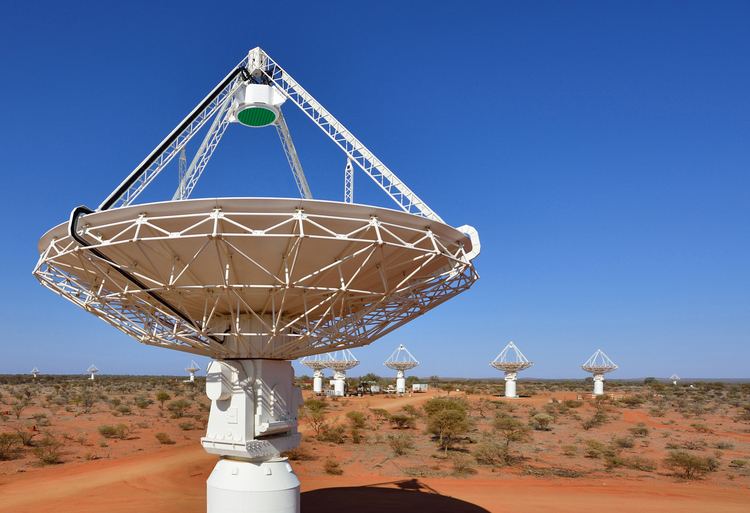Telescope style radio interferometer | ||
 | ||
Organisation Commonwealth Scientific and Industrial Research Organisation Location(s) Murchison Radio-astronomy Observatory , Australia Website www.atnf.csiro.au/projects/askap/ | ||
The australian square kilometre array pathfinder
The Australian Square Kilometre Array Pathfinder (ASKAP) is a radio telescope array located at Murchison Radio-astronomy Observatory (MRO) in the Australian Mid West. ASKAP consists of 36 identical parabolic antennas, each 12 metres in diameter, working together as a single instrument with a total collecting area of approximately 4,000 square metres.
Contents
- The australian square kilometre array pathfinder
- Visit to the australian square kilometre array pathfinder
- Description
- Design
- Science
- ASKAP Survey Science Projects
- Highest Priority
- Slightly Lower Priority
- References
It is operated by the governmental research agency CSIRO and forms part of the Australia Telescope National Facility.
ASKAP's combination of fast survey speed and high sensitivity will allow activities such as researching the creation and early evolution of the Universe, analysing cosmic magnetism, testing predictions of the general theory of relativity, mapping black holes, and exploring the origins of galaxies.
ASKAP is also a technology demonstrator for the international Square Kilometre Array (SKA), a planned radio telescope that is planned to be the world's largest and most sensitive. The ASKAP's home, the MRO, has also been selected as one of the SKA's two central location.
Construction on ASKAP began in late 2009 and was completed in October 2012, at which point it became world's fastest radio telescope.
Visit to the australian square kilometre array pathfinder
Description
Development and construction of ASKAP was led by CSIRO Astronomy and Space Science (CASS), in collaboration with scientists and engineers in The Netherlands, Canada and the USA, as well as colleagues from Australian universities and industry partners in China.
The Wajarri Yamatji people are the traditional owners of the land on which the observatory lies.
Design
The construction and assembly of the dishes was completed in June 2012.
The features that will make ASKAP an unprecedented synoptic telescope include a wide field-of-view, large spectral bandwidth, extremely fast survey speed, and excellent u-v coverage.
ASKAP is located in the Murchison district in Western Australia, a region that is extremely "radio-quiet" due to the low population density and resultant lack of radio interference (generated by human activity) that would otherwise interfere with weak astronomical signals.
The unique radio quiet nature is being recognised as a natural resource and is being protected by the Australian Commonwealth and Western Australia State Government through a range of protective regulatory measures.
Data from ASKAP will be transmitted from the MRO to a supercomputer at the Pawsey Supercomputing Centre in Perth. The data will be converted to images of the sky in near-real-time by a pipeline processor running the purpose-built ASKAPsoft package. All data will be placed in the public domain after being checked for quality by the ten ASKAP Survey Science Teams. Post processing will be supported by supercomputers operated by iVEC at the Pawsey Centre in Perth, and may also be complemented by 'theSkyNet', a "community computing initiative" similar to Seti@home.
Science
During ASKAP's first five years of operation, at least 75% of its time will be used for large Survey Science Projects. ASKAP is expected to make substantial advances in key areas, including the following:
- Galaxy formation and gas evolution in the nearby Universe through extragalactic HI surveys
- Evolution, formation and population of galaxies across cosmic time via high resolution, continuum surveys
- Characterisation of the radio transient sky through detection and monitoring (including VLBI) of transient and variable sources, and
- Evolution of magnetic fields in galaxies over cosmic time through polarisation surveys.
ASKAP Survey Science Projects
In 2009, after an open call for proposals, CSIRO announced that ten major science projects had been selected to use ASKAP. Of the ten projects’ authors, 33% were from Australia and New Zealand, 30% from North America, 28% from Europe, and 9% from elsewhere in the world.
The ten ASKAP Survey Science Projects are:
